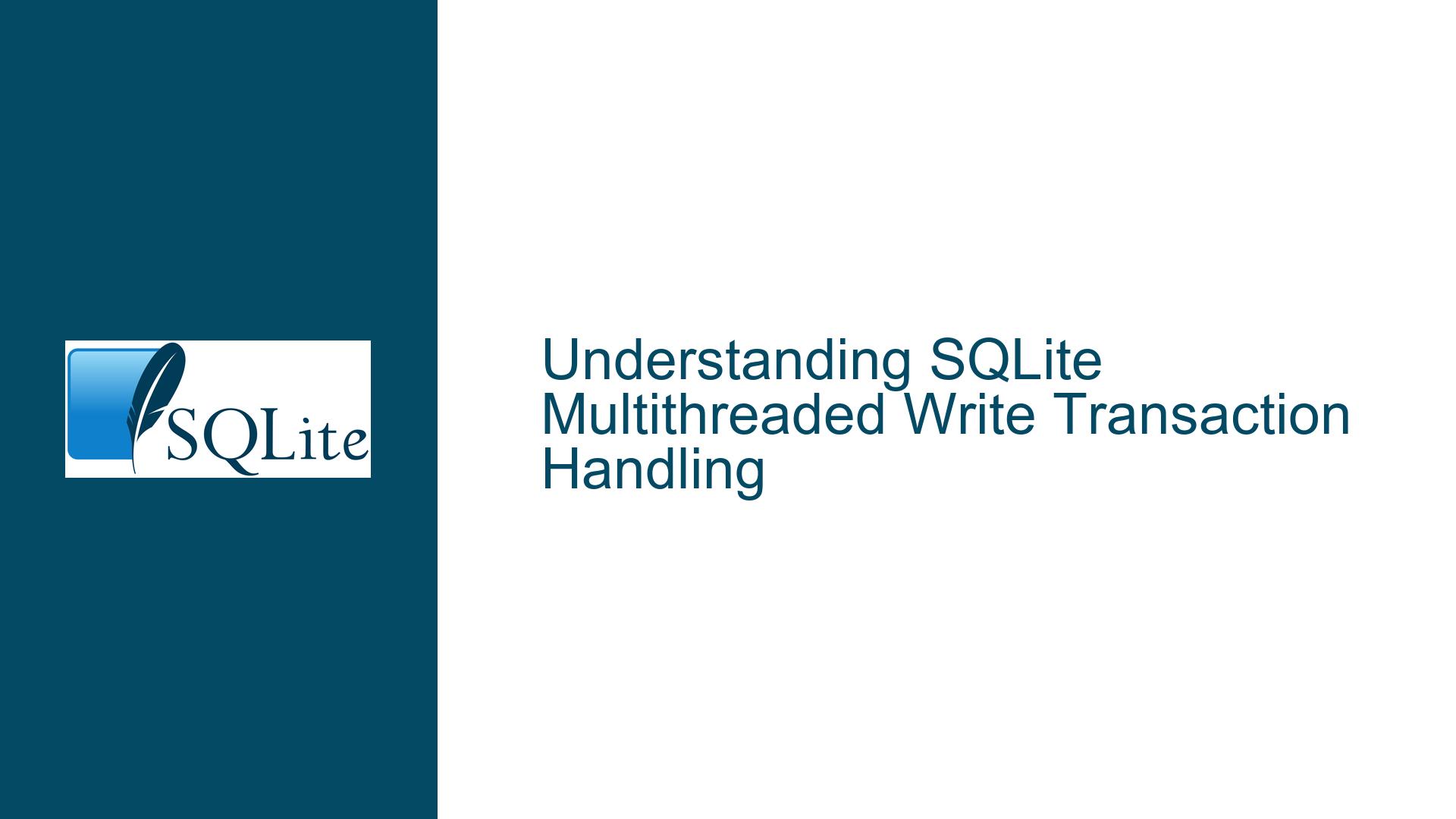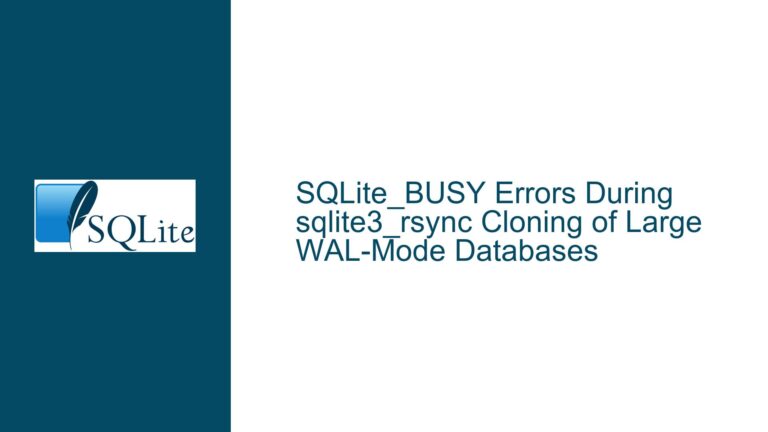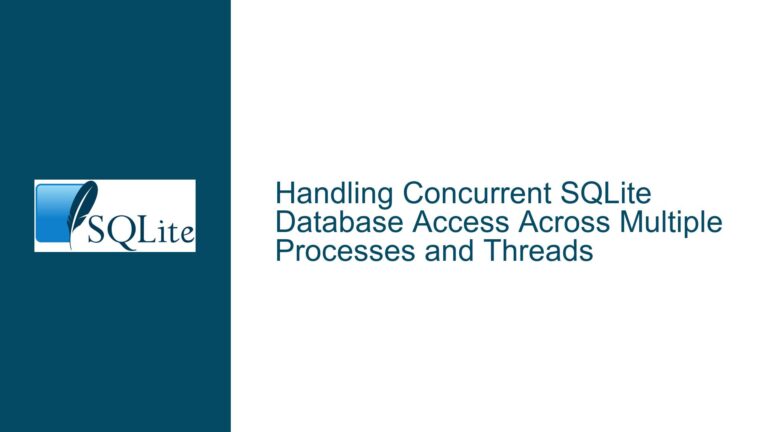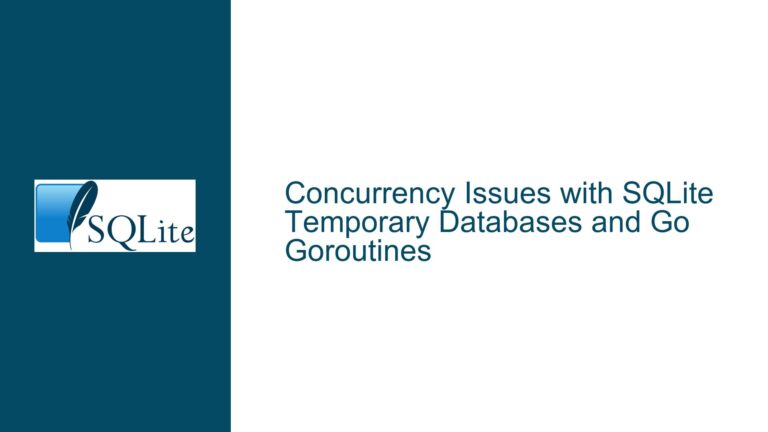SQLite Multithreaded Write Transaction Handling
Issue Overview: Concurrent Write Transactions in SQLite with Multiple Threads
SQLite’s approach to multithreaded write transactions is often misunderstood due to its nuanced handling of database connections, threading modes, and transaction isolation. The core issue revolves around scenarios where two or more threads attempt to initiate write transactions concurrently—either on the same database connection or separate connections. The confusion arises from SQLite’s documentation stating that only one simultaneous write transaction is permitted, while also emphasizing thread safety in "serialized" mode.
When a first thread starts a write transaction, and a second thread attempts to initiate another write transaction, the behavior depends on two critical factors:
- Connection Sharing: Whether the threads share a single database connection or use separate connections.
- Threading Configuration: Whether SQLite is compiled with
SQLITE_THREADSAFE=1(serialized mode) or a different threading mode.
If threads share a single connection in serialized mode, SQLite serializes access to the connection via internal mutexes. The second thread’s write transaction request will block until the first thread completes its transaction. If separate connections are used, the second thread’s write attempt will either block or return an error (e.g., SQLITE_BUSY or SQLITE_LOCKED), depending on the database lock state and configuration settings like busy timeouts.
The ambiguity stems from conflating database connections with database files. A single database file can have multiple connections open across threads or processes. Each connection operates independently, but SQLite enforces strict write-exclusion rules at the database file level. Even in serialized mode, where a single connection is thread-safe, multiple connections to the same database file cannot perform concurrent writes.
Possible Causes: Why Concurrent Write Transactions Fail or Block
1. Shared Database Connection with Serialized Threading Mode
When multiple threads share a single database connection configured in serialized mode, SQLite uses mutexes to ensure that only one thread accesses the connection at a time. If Thread A starts a write transaction, Thread B’s attempt to begin a write transaction will block at the OS level until Thread A releases the connection mutex. However, this does not guarantee success: if Thread A’s transaction modifies the database, Thread B’s subsequent write might still fail due to schema changes or constraints.
2. Separate Database Connections Competing for Write Locks
If each thread uses its own database connection, SQLite’s file locking mechanism comes into play. The first connection to acquire a write lock (via BEGIN IMMEDIATE or BEGIN EXCLUSIVE) blocks other connections from writing. By default, subsequent write attempts return SQLITE_BUSY immediately. This behavior changes if the application configures a busy handler (e.g., sqlite3_busy_timeout()), which retries the operation for a specified duration before failing.
3. Misconfigured Threading Mode
SQLite supports three threading modes:
- Single-thread: All API calls must originate from the same thread.
- Multi-thread: Connections cannot be shared across threads.
- Serialized (default): Connections can be shared safely across threads.
If the library is compiled with SQLITE_THREADSAFE=0 (single-thread) or =2 (multi-thread), using a connection across threads invokes undefined behavior, including crashes or data corruption. Even in serialized mode, improper use of connections (e.g., not finalizing statements before releasing the mutex) can lead to errors.
4. Uncoordinated Transaction Lifecycles
Transactions that span multiple operations (e.g., BEGIN, followed by INSERT, then COMMIT) are vulnerable to interference. If Thread A begins a write transaction but does not commit it promptly, Thread B’s write attempt may block indefinitely or timeout, depending on the busy handler. This is exacerbated in WAL (Write-Ahead Logging) mode, where readers and writers can coexist, but multiple writers still serialize their transactions.
5. Database Lock Escalation Conflicts
SQLite uses lock escalation to manage concurrency:
- UNLOCKED → SHARED (read) → RESERVED (write pending) → PENDING (block new readers) → EXCLUSIVE (write active).
If Thread A holds a RESERVED lock (e.g., after BEGIN IMMEDIATE), Thread B’s attempt to acquire a RESERVED lock will fail with SQLITE_BUSY. If Thread A escalates to EXCLUSIVE, Thread B’s write attempt will block until Thread A commits or rolls back.
Troubleshooting Steps, Solutions & Fixes
Step 1: Verify Threading Mode and Connection Sharing
Action: Confirm the SQLite library’s threading mode using sqlite3_threadsafe(). If the mode is not serialized (SQLITE_THREADSAFE=1), sharing connections across threads is unsafe.
Solution:
- Compile SQLite with
-DSQLITE_THREADSAFE=1to enable serialized mode. - If using separate connections, ensure each thread opens its own
sqlite3*handle.
Example:
int thread_safe = sqlite3_threadsafe();
if (thread_safe != 1) {
// Handle error: threading mode incompatible with shared connections
}
Step 2: Use Separate Connections with Busy Handlers
Action: If threads use separate connections, configure a busy handler to retry failed write transactions.
Solution:
- Set a busy timeout with
sqlite3_busy_timeout(db, timeout_ms). - Implement a custom busy handler for finer control.
Example:
// Set a 2-second busy timeout
sqlite3_busy_timeout(db, 2000);
// Custom busy handler
int busy_handler(void* data, int attempts) {
if (attempts >= 5) return 0; // Abort after 5 retries
usleep(100000); // Wait 100ms
return 1; // Retry
}
sqlite3_busy_handler(db, busy_handler, NULL);
Step 3: Explicitly Manage Transaction Locks
Action: Use BEGIN IMMEDIATE or BEGIN EXCLUSIVE to acquire write locks early, reducing contention.
Solution:
- Replace
BEGINwithBEGIN IMMEDIATEto escalate to RESERVED lock immediately. - Use
BEGIN EXCLUSIVEto bypass RESERVED and acquire PENDING directly (rarely needed).
Example:
-- Thread A
BEGIN IMMEDIATE;
INSERT INTO table1 VALUES (...);
COMMIT;
-- Thread B (blocks until Thread A commits)
BEGIN IMMEDIATE;
INSERT INTO table1 VALUES (...);
COMMIT;
Step 4: Enable WAL Mode for Read/Write Concurrency
Action: Switch the database to Write-Ahead Logging (WAL) mode to allow readers and writers to coexist.
Solution:
PRAGMA journal_mode=WAL;
Benefits:
- Readers do not block writers, and writers do not block readers.
- Multiple writers still serialize write transactions but with reduced contention.
Caveats:
- WAL requires exclusive access during checkpointing.
- Not suitable for network filesystems or certain embedded environments.
Step 5: Implement Application-Level Mutexes
Action: Coordinate write transactions across threads using application-level locks.
Solution:
- Use a mutex or semaphore to ensure only one thread attempts a write transaction at a time.
Example (C++):
std::mutex db_mutex;
void thread_func(sqlite3* db) {
std::lock_guard<std::mutex> lock(db_mutex);
// Execute write transaction
}
Step 6: Handle SQLITE_BUSY and SQLITE_LOCKED Errors Gracefully
Action: Check for SQLITE_BUSY (database locked) and SQLITE_LOCKED (table locked) errors and retry.
Solution:
- Wrap write operations in retry loops with exponential backoff.
Example (Python):
import sqlite3
import time
def execute_with_retry(db, query, max_retries=5):
retries = 0
while retries < max_retries:
try:
cursor = db.execute(query)
db.commit()
return cursor
except sqlite3.OperationalError as e:
if "database is locked" in str(e):
retries += 1
time.sleep(0.1 * (2 ** retries))
else:
raise
raise Exception("Max retries exceeded")
Step 7: Minimize Transaction Duration
Action: Keep write transactions as short as possible to reduce contention.
Solution:
- Avoid long-running transactions with multiple unrelated operations.
- Batch updates into a single transaction where feasible.
Anti-Pattern:
BEGIN;
-- Long-running data processing
-- ...
COMMIT;
Best Practice:
-- Process data first, then execute a quick transaction
BEGIN;
INSERT INTO table1 SELECT * FROM temp_table;
COMMIT;
Step 8: Monitor Database Locks and Contention
Action: Use SQLite’s sqlite3_status() API or pragmas to diagnose lock contention.
Solution:
- Query
PRAGMA database_list;to identify attached databases. - Use
sqlite3_status(SQLITE_STATUS_PAGECACHE_SIZE, ...)to monitor memory usage.
Example:
int highwater = 0;
int current = 0;
sqlite3_status(SQLITE_STATUS_PAGECACHE_SIZE, ¤t, &highwater, 0);
printf("Page cache usage: %d (peak: %d)\n", current, highwater);
Step 9: Avoid Shared Cache Mode in Multi-Threaded Environments
Action: Disable shared cache mode (SQLITE_OPEN_SHAREDCACHE) to prevent unintended lock coupling.
Solution:
- Open connections with
SQLITE_OPEN_PRIVATECACHEto isolate caches.
Example:
sqlite3_open_v2("file:data.db?cache=private", &db, SQLITE_OPEN_READWRITE | SQLITE_OPEN_PRIVATECACHE, NULL);
Step 10: Test with Stress Workloads and Debug Logging
Action: Simulate high-concurrency scenarios to validate transaction handling.
Solution:
- Enable SQLite’s debug logging with
sqlite3_config(SQLITE_CONFIG_LOG, ...). - Use tools like
systraceorstraceto monitor system calls.
Example:
void log_callback(void* arg, int code, const char* msg) {
printf("SQLite Log (%d): %s\n", code, msg);
}
sqlite3_config(SQLITE_CONFIG_LOG, log_callback, NULL);
By systematically addressing connection management, threading configuration, lock contention, and error handling, developers can ensure robust multithreaded write transaction handling in SQLite.






